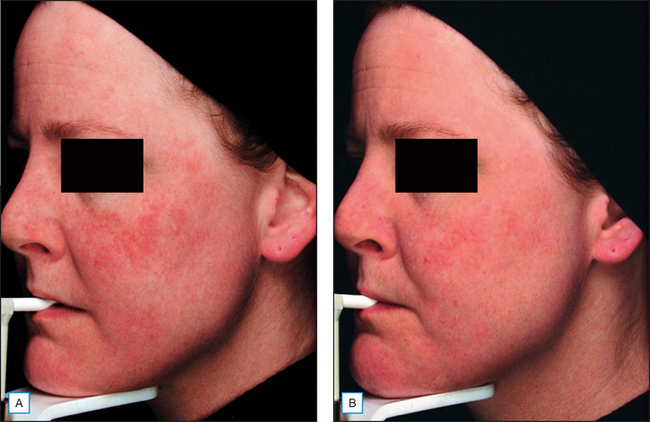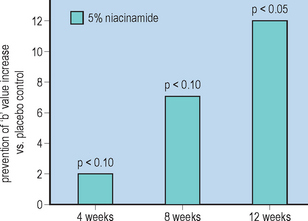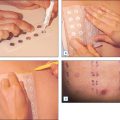Chapter 9 Cosmeceutical Vitamins: Vitamin B
NIACINAMIDE
• Topical cosmeceutical effects
BARRIER AND IRRITATION
Topical niacinamide reduced transepidermal water loss (TEWL), indicating improved barrier function. The treated skin was found to be significantly more resistant to damage by barrier-destructive agents such as the surfactant sodium lauryl sulfate (SLS) and trans-retinoic acid. This translates into less irritation and facial red blotchiness (Fig. 9.1).
YELLOWING (SALLOWNESS)
With topical niacinamide, yellowing was significantly prevented (Figs 9.2 and 9.3). The mechanism for this may involve antioxidancy via NAD(P)H, specifically prevention of protein glycation (Maillard reaction), the end products of which are cross-linked yellow-brown proteins (Amedori products) that accumulate in skin. Niacinamide has been reported to have antiglycation properties.
WRINKLES
A small but significant wrinkle reduction activity is observed after chronic topical niacinamide treatment (Fig. 9.4). There are two mechanisms which have been explored regarding this wrinkle reduction: an increase in dermal collagen production and a decrease in excess upper dermal glycosaminoglycan (GAG) production. While a low level of GAG is required for normal structure and function of the dermal matrix, excess levels are associated with poor visible appearance of skin.
PANTHENOL
• Topical cosmeceutical effects
BARRIER AND IRRITATION
Panthenol protects against irritation via improvement in skin barrier function. Topical pre-treatment with panthenol was observed to increase skin’s resistance to visible irritation upon subsequent exposure to the surfactant SLS (Table 9.1). Since panthenol is the precursor to pantothenic acid, which is a cofactor in barrier layer lipid biosynthesis, this could account for the noted barrier effect.
Table 9.1 Prevention of SLS-induced erythema by topical panthenol
| Erythema score (0–6 scale) for skin treated with: | ||
| Time point post SLS treatment | SLS | Panthenol then SLS |
| 2 days | 4.0 | 2.4 |
| 3 days | 3.4 | 1.7 |
| 4 days | 2.7 | 1.4 |
Some consumers are sensitive to specific components (e.g. certain preservatives, fragrances, sunscreen actives, etc.) in cosmetic formulations, leading to induction of negative kinesthetic irritation effects such as burn, sting, itch, and tingling. Topical panthenol incorporated into such formulations can reduce those negative effects (Table 9.2). The mechanism for this may be related to the reported soothing or anti-inflammatory effect of panthenol.
Table 9.2 Reduction in negative kinesthetic effects of formulation containing panthenol
| Visible or kinesthetic attribute | Reduction in attribute by panthenol (0–6 scale) |
| Redness | − 1.4 |
| Burning | − 2.4 |
| Tingling | − 5.7 |
| Stinging | − 4.9 |
| Itching | − 4.9 |
| Warming | − 5.7 |
Biro K, Thaci D, Ochsendorf FR, Kaufmann R, Boehncke WH. Efficacy of dexpanthenol in skin protection against irritation: a double-blind, placebo-controlled study. Contact Dermatitis. 2003;49:80–84.
Bissett DL, Oblong JE, Saud A, Berge CA, Trejo AV, Biedermann KA. Topical niacinamide provides skin aging appearance benefits while enhancing barrier function. Journal of Clinical Dermatology. 2003;32:S9-S18.
Bissett DL, Miyamoto K, Sun P, Li J, Berge CA. Topical niacinamide reduces yellowing, wrinkling, red blotchiness, and hyperpigmented spots in aging facial skin. International Journal of Cosmetic Science. 2004;26:231–238.
CIR. Final report of the safety assessment of niacinamide and niacin. International Journal of Toxicology. 2005;24S:1–31.
Draelos ZD. Niacinamide-containing facial moisturizer improves skin barrier and benefits subjects with rosacea. Cutis. 2005;76:135–141.
Draelos ZD, Ertel KD, Berge CA. Facilitating facial retinization through barrier improvement. Cutis. 2006;78:275–281.
Draelos ZD, Matsubara A, Smiles K. The effect of 2% niacinamide on facial sebum production. Journal of Cosmetic and Laser Therapy. 2006;8:96–101.
Ebner F, Heller A, Rippke F, Tausch I. Topical use of dexpanthenol in skin disorders. American Journal of Clinical Dermatology. 2002;3:427–433.
Fivenson DP. The mechanisms of action of nicotinamide and zinc in inflammatory skin diseases. Cutis. 2006;77S:5–10.
Gehring W. Nicotinic acid/niacinamide and the skin. Journal of Cosmetic Dermatology. 2004;3:88–93.
Gloor M, Senger B, Gehring W. Do dexpanthenol/glycerin combinations achieve better skin hydration than either component alone? Aktuelle Dermatologie. 2002;28:402–405.
Greatens A, Hakozaki T, Koshoffer A, et al. Effective inhibition of melanosome transfer to keratinocytes by lectins and niacinamide is reversible. Experimental Dermatology. 2005;14:498–508.
Hakozaki T, Minwalla L, Zhuang J, et al. The effect of niacinamide on reducing cutaneous pigmentation and suppression of melanosome transfer. British Journal of Dermatology. 2002;147:22–33.
Kang HT, Lee HI, Hwang ES. Nicotinamide extends replicative lifespan of human cells. Aging Cell. 2006;5:423–436.
Matts PJ, Oblong JE, Bissett DL. A review of the range of effects of niacinamide in human skin. International Federation of the Societies of Cosmetic Chemists Magazine. 2002;5:285–289.
Niren NM. Pharmacologic doses of nicotinamide in the treatment of inflammatory skin conditions: a review. Cutis. 2006;77S:11–16.
Proksch E, Nissen HP. Dexpanthenol enhances skin barrier repair and reduces inflammation after sodium lauryl sulphate-induced irritation. Journal of Dermatological Treatment. 2002;13:173–178.
Reber F, Geffarth R, Kasper M, et al. Graded sensitiveness of the various retinal neuron populations on the glyoxal-mediated formation of advanced glycation end products and ways of protection. Graefes Archive for Clinical and Experimental Ophthalmology. 2003;241:213–225.
Romiti R, Romiti N. Dexpanthenol cream significantly improves mucocutaneous side effects associated with isotretinoin therapy. Pediatric Dermatology. 2002;19:368.
Sauberlich HE. Pantothenic acid. In: Goodhart RS, Shils ME, editors. Modern nutrition in health and disease. Philadelphia: Lea & Febiger; 1980:209–216.
Shindo Y, Witt E, Han D, Epstein W, Packer L. Enzymic and non-enzymic antioxidants in epidermis and dermis of human skin. Journal of Investigative Dermatology. 1994;102:122–124.
Soma Y, Kashima M, Imaizumi A, Takahama H, Kawakami T, Mizoguchi M. Moisturizing effects of topical nicotinamide on atopic dry skin. International Journal of Dermatology. 2005;44:197–202.
Stozkowskaa W, Piekos R. Investigation of some topical formulations containing dexpanthenol. Acta Poloniae Pharmaceutica. 2004;61:433–437.
Thornalley PJ. Glycation in diabetic neuropathy: characteristics, consequences, causes, and therapeutic options. International Review of Neurobiology. 2002;50:37–57.
Wozniacka A, Sysa-Jedrzejowska A, Adamus J, Gebicki J. Topical application of NADH for the treatment of rosacea and contact dermatitis. Clinical and Experimental Dermatology. 2003;28:61–63.








